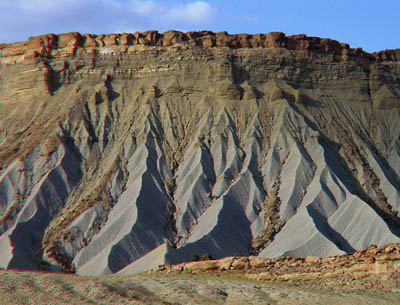badlands

The Mancos Shale badlands in Capitol Reef National Park, Utah.
Badlands are arid to semiarid areas of pinnacles, ridges, and gullies, usually lacking in vegetation, formed by heavy erosion of non-uniform rock. Because of the lack of adequate vegetation (due to climate or human intervention), rainwater runs off very quickly and erodes soft and exposed rock.
These harsh environments can be found all over the world, from the Mojave Desert in the United States to the Gobi Desert in Asia. Despite their inhospitable nature, badlands have played a significant role in the history of human civilization and continue to fascinate people today.
One of the most famous badlands in the world is the Badlands National Park in South Dakota, United States. This park is home to a unique ecosystem that has been shaped over millions of years by forces such as erosion, wind, and water. The Badlands are home to a variety of plant and animal species that have adapted to the harsh conditions, including bison, pronghorn, bighorn sheep, and prairie dogs.
The history of the Badlands is just as interesting as its landscape. Native Americans, including the Lakota Sioux and the Cheyenne, lived in the area for thousands of years before European settlers arrived. The Badlands were also home to many fossil discoveries, including the famous Tyrannosaurus rex specimen known as "Sue."
In addition to its natural beauty and rich history, the Badlands have also played a role in American folklore and literature. The outlaws Bonnie and Clyde famously fled through the Badlands during their crime spree in the 1930s. The region was also the inspiration for the novel "On the Road" by Jack Kerouac.
Despite their rugged and unforgiving nature, badlands have a unique beauty that draws people to them. Many people visit the Badlands National Park each year to experience the stunning landscapes and learn about the history and ecology of the region.
However, badlands are also vulnerable to environmental threats such as climate change and human development. As the world's population grows, there is an increasing demand for land and resources, which can lead to the destruction of these fragile ecosystems. It is important that we take steps to protect badlands and other unique landscapes around the world.


